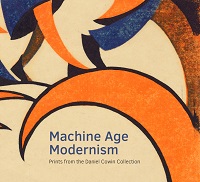
FEBRUARY 28–May 17, 2015
Printmaking Processes
DRYPOINT
In the drypoint process, an artist scratches directly into a copper plate with a sharp-pointed needle. The scratching displaces metal along the incised lines. The displaced metal is called “burr.” The burr holds ink during the printing process, giving the printed lines a characteristically fuzzy look. To print the image the plate is inked and wiped, a damp piece of paper is placed over the plate, and both are put into a printing press. The press pushes the paper down into the grooves of the plate, transferring ink to paper.
LITHOGRAPHY
Lithography is based on the premise that oil and water repel each other. The artist draws an image on a porous lithographic stone using a greasy crayon or oil-based liquid. The image is then “fixed” onto the stone with a mixture of gum arabic and nitric acid. To print the image, the stone is thoroughly dampened with water, and an oil-based ink is rolled onto the stone. The ink is attracted only to the previously drawn greasy areas. A sheet of paper is placed on the stone, and both go through a lithographic printing press.
WOODCUT
Woodcuts make use of a relief printing process. A wood block is cut away using a variety of tools, with the image to be printed left raised. Ink is then rolled onto the raised parts of the block’s surface. A piece of paper is laid on the block, and pressure is applied either by hand or in a press to print the image.
LINOCUT
Like wooduts, linocuts are made using a relief printing process. The artist draws the image onto a linoleum block, then uses various tools to remove parts of the surface. The remaining raised image, or relief, is then directly inked for printing. Paper is placed on the block, and pressure is applied either by hand or mechanically. Color linocutters often use a separate carved block for each color. Linoleum blocks are softer and easier to cut than wood blocks, permitting the artist a greater freedom in cutting the block.

Machine Age Modernism is accompanied by a fully illustrated catalogue with essays by Jonathan Black, a senior research fellow in the history of art at Kingston University in London, and Jay A. Clarke, Manton Curator of Prints, Drawings, and Photographs at the Clark.
